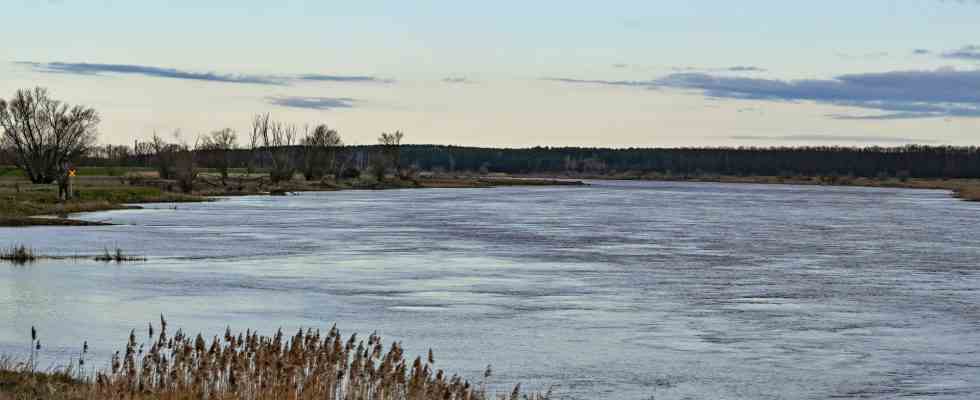Status: 03/27/2023 1:44 p.m
At a conference today, the Greens are discussing better protection for the Oder. But a visit to the industrial region in the south of Poland shows that wastewater discharges are still daily practice there.
A boat trip on the Oder, around 350 kilometers from the German border. The water on which the angler Grzegorz Marcinkiewicz is fishing does not look inviting. It looks brown and lifeless in these spring days, no green sprouts on the bank. A few mallards here and there, but there doesn’t seem to be much more life.
Angler Marcinkiewicz used to see the river as his livelihood: he wanted to offer sport fishing courses here, with a brand new boat complete with modern sonar equipment that he could use to track down fish. “There! There’s one!” he calls almost euphorically.
Because since the great fish kill last summer, the animals in the Silesian part of the Oder are almost a rarity. “It’s a total tragedy,” laments the young man. “Everything collapsed, my earnings, my hobby, my passion. Because I can’t just sit here while the fish are gone. I used to catch record size fish here.”
“Several mass deaths last year”
Marcinkiewicz was one of the first to publicize the consequences of the Oder pollution. With his tattoos, athletic build and trendy clothes, he looks more like an influencer than a fisherman. He advertises on his website with various video streams and web videos on the subject of fishing.
But on his YouTube channel, the documentation of an environmental disaster has also emerged since last year. Marcinkiewicz started his records long before the fish kill reached the German border.
“There were several mass deaths here last year,” he comments on the pictures on his smartphone. “It all started in February, March, then again and again in June, July, August and September – and what happened happened.” Blue garbage bags on the banks testified to the fish kill long before the initially mysterious mass die-off became visible in Germany.
Polish authorities pretend to be ignorant
To this day, Polish authorities appear to be rather ignorant of the development and origin of the disaster. Environmentalists like Agnieszka Konowaluk are clearly upset by this indifference. She volunteers as a river guard at the World Wildlife Fund and takes us to the point where a lot of sewage from the industrial region around Gliwice ends up in the Oder via a tributary.
“There are days when foam forms on the river,” Konowaluk describes the situation. “Sometimes it’s yellow, sometimes white. Sometimes the river stinks of phenol and other chemical substances, depending on the time of year and the temperature.” Last year, she says, dead fish and other dead animals such as beavers swam here too.
Wastewater from coal mines
But where did the pollution come from, for which no one wants to be responsible to this day? The environmental protection organization Greenpeace believes that salt discharges are the cause and presented the results of wastewater analyzes in Warsaw at the beginning of March. Accordingly, the salt content of the samples taken is around three times as high as in the quite salty water of the Baltic Sea. This salt concentration favored the growth of algae, which are deadly for the fish.
The origin of this problem: the coal mines in the Silesian region. Not least because of the energy crisis, hard coal is mined here in piecework. Deep down in the tunnels, this creates a lot of saline mine waste water. It is constantly pumped out and ends up in the rivers.
This becomes visible in an inconspicuous gully near the town of Zabrze. Coal mine winding towers line the horizon. Suddenly, gurgling noises begin behind a barrier. A torrent of mine sewage pours into the watercourse and a few hundred meters further into a tributary of the Oder. There are dozens of such places in the region, environmentalists report.
Hardly any monitoring of discharges
The mine operators have permits for the discharges themselves. But the accusation of the environmentalists is that the supervisory authorities only laxly monitor what really ends up in the Oder. “There is no evidence of any danger to people,” says Malgorzata Marciniewicz-Mykieta from the Warsaw Environmental Protection Agency. “Our investigations show no health risk.”
Those familiar with the situation, such as angler Grzegorz Marcinkiewicz, see things differently. He steers his boat to a point where waste water from a coking plant’s sewage treatment plant flows into the Oder. The water shimmers darkly, the embankment shows deposits.
The extent of the discharges can be seen from the air: the sewage mixes with the water of the Oder in black clouds. There is no doubt: in Poland, the river is more of a water body than a biotope. Angler Marcinkiewicz thinks more fish kills are likely. At the latest when the temperatures rise in summer and the amount of water drops.

